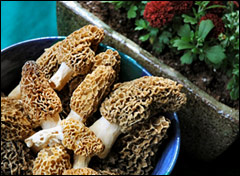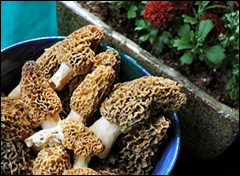As Earth Day approaches this year, it seems that people are thinking more about food’s price than its ecological footprint. A simple trip to the grocery store tells the same story we’ve been hearing on the news: it’s getting more and more expensive to feed ourselves.

The morel of the story.
I’ve been thinking a lot about food prices, too. After holding off for almost a year, I raised the prices at my restaurant. I was able to avoid it longer than some of my fellow restaurant owners, partly because I have relatively low overhead: a small space and a small staff. Also, we buy all our meat and dairy — and roughly 60 percent of everything else — from nearby sustainable farms and food artisans. By buying locally as much as possible, we staved off the effects of higher fuel costs on prices. But now our local suppliers have their own rising costs to contend with, so they pass their costs along to their customers (me), and I pass them along to mine (you). Round and round we go.
All this got me thinking about an essay I read a few years back by nutritionist Joan Dye Gussow called “The Incompatibility of Food and Capitalism” [PDF]. In a nutshell, she argued that while capitalism is a fine system for creating and distributing things like cars and computers, it isn’t well designed to handle the production and dispersal of food.
Marketers work their magic to make us need (or think we need) more and more TVs, computers, cars, and snowmobiles, but they can’t make us need more food. Even on the more-than-ample diet of the average American, we can still only eat about 1,500 pounds of food per year. The capitalist solution, Gussow said, was to put less food in our food, thus necessitating that we buy more of it. This leads to things like fruit juice cans on store shelves that proudly proclaim that they contain “10% real fruit juice!”
Here in the United States, many of us are relatively buffered from the agony of food scarcity in places like Haiti. At my restaurant, most of my clientele probably won’t notice the modest increases in the cost of their paella or sangria. For those who do notice, I hope they’ll note that the economic situation affects us all and will continue to patronize my place. Like our customers, my staff and I need to feed and shelter our kids; running an artisanal restaurant is how we get the money to do it.
But despite our efforts to help rebuild an ecologically and socially responsible food system, my humble little place won’t put food on the tables of low-income folks in South Central L.A. or Mississippi or Somalia. Thing is, the cheap-food system that has been more or less feeding the poor for decades isn’t doing a very good job of that, either.
As we head into Earth Day, I hope people all over the world will rethink the logic of food production. Rather than the focus on expanding markets at any cost, I hope we strive to move sustainability and quality to the center of food production. If we manage to do so, I think we’ll learn to value the work of small-scale, diversified farms the world over. I have a feeling that such a new food paradigm would do better at providing real food security than the current one, which is now in crisis.
In the spirit of Earth Day in a time of food crisis, here’s an earthy recipe that nevertheless treads lightly on the earth and pocketbook alike. Total cost to you: about $0.35 per serving, plus a walk in the woods. It involves foraging for wild mushrooms, a lost art in the United States. Mushroom foraging is immensely satisfying, but shouldn’t be embarked upon lightly. Here’s a basic primer. If you don’t have the time or access to land to forage, you can substitute cultivated mushrooms, such as creminis, from the grocery store. Creminis deliver good flavor for the price.
Sautéed Morels with Lemon
Serves 8 as a snack or appetizer.
2 eggs (preferably local and truly free-range), beaten
1/3 cup flour, seasoned lightly with salt and pepper
1/2 cup olive oil
1/4 cup dry white wine
2 lemons
Salt and pepper, to taste
24 first-of-spring lettuce leaves, for garnish
Split the mushrooms lengthwise and rinse them thoroughly. Look out for ants that sometimes live in the hollow insides of the fungus head. (If using creminis, quarter them.) Pat the mushrooms dry with clean terry cloth. Toss in the seasoned flour until thoroughly coated, then set aside.
Split one lemon and juice it. Mix this juice with the wine. Cut the other lemon into 8 wedges. Heat 1/4 cup of the olive oil in a large sauté pan over medium high heat.
Test the oil with a drop of the egg. If it browns quickly (but not immediately — that would be too hot), it’s ready. Dip the dusted morels into the egg, let the excess drip off, then place them carefully in the pan. Do not over-fill the pan.
Sauté two minutes on the one side and then gently turn them to cook on the other side for another couple of minutes. Remove to a clean terry cloth, and proceed in the same manner with the remaining mushrooms. Be careful not to let the mushrooms scorch; if necessary, lower the heat.
When all the mushrooms are finished, add the wine-lemon mixture to the pan and stir with a wooden spoon, scraping up any bits of browned flavor and juices that cling to the bottom. (This is called “deglazing the pan.”) Let the liquid simmer for a couple of minutes, then strain through a fine mesh sieve or through cheesecloth.
On clean plates, place 5 mushroom halves on the plate in a star pattern. Garnish with a lemon wedge and the baby lettuce leaves. Drizzle with the lemon-wine mixture and serve immediately.


